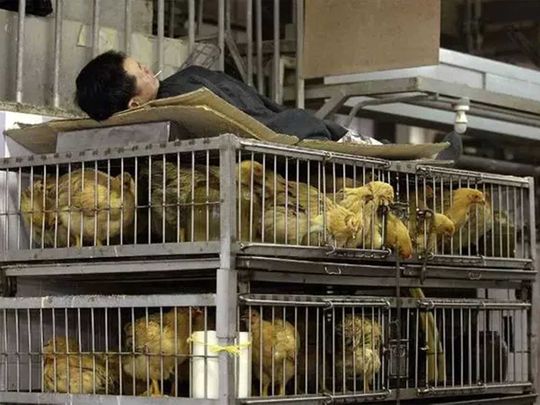
The Chinese move to reopen wet markets has been greeted by a chorus of protests around the world, because many believe these markets are the source of the new coronavirus.
Is it true? Maybe, but there’s no firm evidence yet. Here’s what the reports say: 27 of the initial cluster of 41 hospitalised patients (but not the first recorded patient) had visited the Huanan Seafood Wholesale Market in Wuhan, which is thought to be the source of SARS-CoV-2, the virus that has been rampaging around the globe.
Although some cases have no exposure to the market, its link to the virus seems likely. That has prompted authorities in China to close down the wet markets, around three months ago.
The lockdown in Wuhan, where the new coronavirus is believed to have originated, was lifted on April 8. Soon the Baishazhou wet market, one of the biggest in the city, was buzzing again. That’s when protests erupted, complaining of China’s lax approach to a global pandemic.
The wet markets in China and some other parts of Asia are an essential part of everyday life. They provide clean, fresh produce. To the rest of the world, these are markets with dodgy hygiene. That’s not entirely true.
Without wet markets, the Chinese food distribution system will come to a halt. Why else would the Chinese be in haste to open these markets?
What is a wet market?
‘Wet market’ is a term that originated in Hong Kong and Singapore to differentiate markets selling fresh meat and fresh produce from ‘dry’ markets which sell packaged and durable goods such as textiles and electronics, a report in The Conversation says.
More like the farmers’ markets in the west, it’s the traditional backbone of China’s food supply system. The wet markets in big cities are generally well-managed and hygienic, but the cleanliness and sanitation can be spotty in markets in smaller communities.
Wet markets are not limited to China. These public markets are found across Southeast Asia: Hong Kong, Malaysia, Singapore, Taiwan, the Philippines, Vietnam, Indonesia, and in countries with Chinese diaspora.
Why are these markets popular?
Wet markets are popular because the products are less expensive and fresher than in supermarkets. There’s no refrigeration, and everything must be sold on the day. The markets also offer opportunities to strike bargains and are social interaction spaces.
These places play a vital role in passing down cultural food knowledge. Vendors often make recommendations and discuss recipes with the customers, advising them on ingredients that traditionally go together, a Los Angeles Times report said, adding that the markets nurture long-term relationships between customers and vendors.
The markets also provide rural migrants with a chance to earn a relatively high income and move up the social ladder.
Wet markets are good for children’s health. It’s true
A 2012 study based on China Health and Nutrition Survey found that when families have access to wet markets, children eat less manufactured supermarket food, which has higher amounts of added salt and sugar, the Los Angeles Times reported. These markets are integral to providing nutritious food for children, particularly of low-income families.
Is hygiene an issue?
Hygiene may not be a problem in major cities where they are well-regulated. Beyond that, several reports have pointed to appalling levels of cleanliness and sanitation in some markets. A Bloomberg report cites instances where “animals in are penned and slaughtered or sold live right next to stalls selling fruit and vegetables”. Such places can be a fertile breeding ground for viruses, some of which could mutate and jump the species barrier to humans.
Why the world hates wet markets
Anthropologists Christos Lynteris and Lyle Fearnley say: “In western media, wet markets are portrayed as emblems of Chinese otherness: chaotic versions of oriental bazaars, lawless areas where animals that should not be eaten are sold as food, and where what should not be mingled comes together (seafood and poultry, serpents and cattle).”
Wet markets and wildlife markets. They are different
Wet markets are often confused and conflated with wildlife markets. Most wet markets are not wildlife markets. Some do have a section for wild animals. The vendors also slaughter animals upon customer purchase. That’s where the risk comes in. Such places can spawn zoonotic diseases (diseases that spread from animals to humans).
Some scientists insist that wet markets are not the problem, it’s is the sale of wild animals for consumption which is dangerous. They say these places where humans and wildlife converge increase epidemiological risks.
“It’s misleading to focus on wet markets when we discuss the outbreak,” said Zhenzhong Si, a research associate at the University of Waterloo, told Bloomberg. “It overshadows the true problem here, which is the supply chain of wild animals. We shouldn’t demonise wet markets because of the coronavirus outbreak.”
How are epidemics linked to these markets?
Markets, where wild animals are sold, bring humans in close contact with them. This commingling increases the potential for zoonotic transmission. (from animals to humans).
Scientists say the avian flu (H5N1), SARS (severe acute respiratory syndrome), and COVID-19 can be traced to wet markets, more specifically wildlife markets which sell exotic meat.
The demand for exotic meat
The consumption of wild animals is said to be of appeal to only a small minority of people. Most of the demand comes from the traditional Chinese medicine trade, where exotic meat or animal body parts are used for therapeutic value or as aphrodisiacs. Lot of it is also reported to be rooted in superstitions: eating exotic fish will make you a better swimmer, and owl meat can improve your eyesight.
All exotic animals are not from the wild
A majority of the “wild animals” sold in these markets are bred and raised in captivity. Wild boar, ducks, snakes, bamboo rats, mallard ducks, frogs, or snakes are some of them. Only a small proportion of the animals on sale are caught from the wild.
The call to ban wet markets
It’s important to differentiate between wet markets and wildlife trade. When Elizabeth Maruma Mrema, acting executive secretary of the UN Convention on Biological Diversity, calls for banning “wet markets” that sell live and dead animals for human consumption, she means wildlife markets.
The call to ban wildlife markets has gained in appeal due to the potential for zoonotic diseases and risk to endangered species. A group of US lawmakers, US National Institute of Allergy and Infectious Diseases Director Anthony Fauci, and China Biodiversity Conservation and Green Development Foundation Secretary-General Zhou Jinfeng have all appealed for the closure of wildlife markets worldwide. Former Beatle Paul McCartney, a vegetarian, too lent his voice to the chorus calling for a ban.
Wet markets and wildlife markets, can they be banned?
Closing wet markets isn’t the solution. It’s China lifeline, a place where most Chinese people get their daily sustenance.
“Banning wet markets is not only going to be impossible, but will also be destructive for urban food security in China as they play such a pivotal role in ensuring urban residents’ access to affordable and healthy food,” Si, a research associate at the University of Waterloo, says.
Wet markets were banned from selling wildlife in 2003, soon after the SARS outbreak, but the ban was lifted after the threat faded.
Tighter regulation, not ban, is needed
The pandemic stems from a wildlife regulation problem, not a wet market problem. A ban will push it underground. So instead of a ban, stricter regulations should be enforced to curb illegal trade in exotic animals in the markets. It should also include stringent norms to maintain hygiene.
Awareness, regulation, farm supervision, and legal avenues for consumers are all needed to counter the menace of illegal wildlife trade.
What are the Chinese doing?
A committee of the Chinese Communist Party recently issued a statement vowing to address shortcomings in public health. “It is necessary to strengthen market supervision, resolutely ban and severely crack down on illegal wildlife markets and trade, and control major public health risks from the source,” the statement said.
The world should act
Illegal trade of wildlife is not just China’s problem, there should be a global ban on the commercial sale of wildlife.
The astonishing diversity of wild animals in markets…, packed in small cages in crowded market stalls, created a perfect laboratory for the unintentional incubation of new viruses that can enter human cells. Viruses can be spread through saliva, blood or faeces, Christian Walzer, executive health director of the Wildlife Conservation Society, told the New York Times.
“Each animal is a package of pathogens,” he said.








